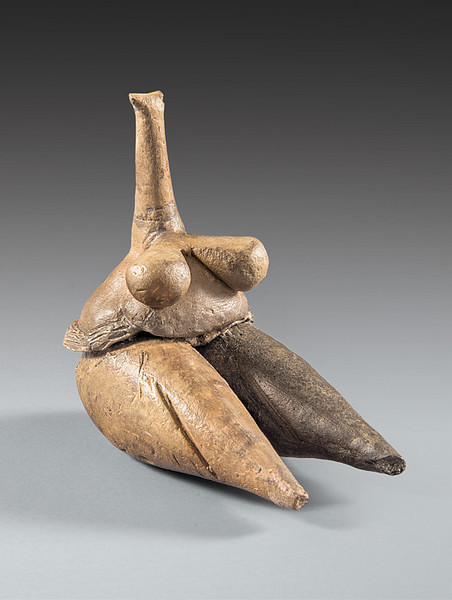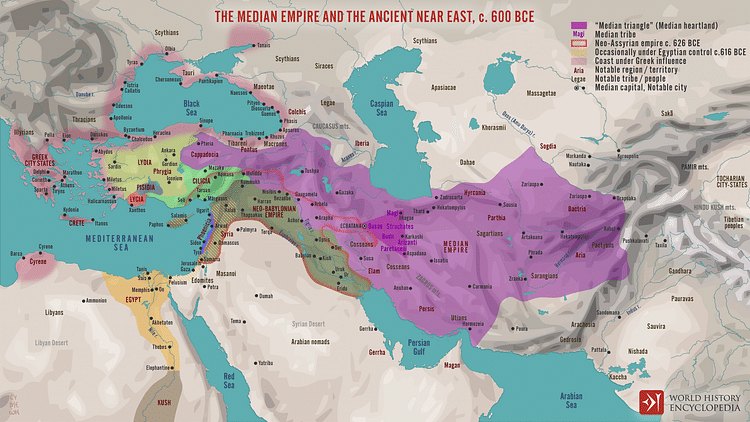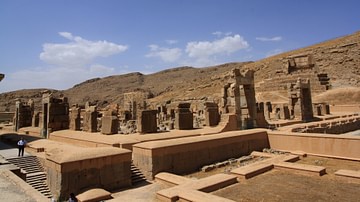
The Medes or Medians were a group of Indo-Iranian-speaking people from central Asia who migrated westwards and entered northern Iran around the end of the 2nd millennium BCE. They settled in the highlands of Zagros (Zagreus in Greek) and, by the end of the 7th century BCE, founded the kingdom of Media (Mada in Old Persian).
Since no written records of the Late Bronze Age migrating groups from Central Asia have been found, it is unclear by what name(s) they used to call themselves. Median (or Medes) was the Greek adaptation of Mada and it referred to the people from the Achaemenid Empire centuries later. The Medians, however, were originally a group of North Zagros tribes or clans, most likely related to each other through language and culture rather than any political rulership. The Median clans were in constant conflict with each other before their unification in the 8th century BCE, mainly to fight back the invasions of the Assyrians from the east and of the Urartians and Scythians from the north.
Median history is studied through two main groups of ancient sources that are not always consistent: Mesopotamian records (particularly Assyrian inscriptions) and historical writings (mainly Herodotus' Histories, 1.95-106). Although both groups might be assessed as external observations, the former is contemporary, while the latter comes from much later. Both, however, agree that the Medians were highly acclaimed horsemen and ruthless warriors, who not only secured their independence from the Neo-Assyrian Empire and other great powers of the region but went further and expanded their borders into the heartland of Mesopotamia, eastern Anatolia, and western Iran.
The Median Empire became a superpower in 612 BCE, following its contribution to the downfall of the Neo-Assyrian Empire. In 549 BCE, when the last king of the Medians, Ishtuvaigu (Astyages in Greek, r. 585 to c. 550 BCE), was defeated by the Persian king of Anshan, Cyrus II (the Great, r. c. 550-530 BCE), the Medians were already renowned as members of a formidable military force, and most ancient writers continued to refer to the Persians as "the Medes" for centuries after their full absorption into the Achaemenid Empire (550-330 BCE).
Pre-Median Zagros
According to archaeological evidence, the North Zagros area was occupied by hunter-gatherer nomads living in caves or temporary huts since the Neolithic period. From the 8th millennium BCE onwards, agricultural settlements appeared in western Iran producing the earliest forms of terracotta figurines and painted pottery, stone tools, axes and arrows, and mudbrick rooms as excavated in Ganj Darreh, Kermanshah.

The earliest civilizations in the Zagros Mountains appeared around the 5th millennium BCE. The first Elamite city-states, such as Susa and Anshan (future birthplace of Cyrus II), had a lot in common with their contemporary Sumerian Uruk culture in southern Mesopotamia, such as religious beliefs and practices, matriarchal political systems (succession of the rulers based on their maternal lineage), and artistic and architectural methods and styles. Although the Elamites spoke a language not related to any other in the area, they did not hesitate to replace their pictographic script with the Sumerian cuneiform. Elements of Mesopotamian religion, rituals, writing systems, and Mesopotamian art and architecture were later transmitted through the Elamites to the Medians and then to the Persians, forming the foundations of the ancient Persian culture that lived on in the Persian-Islamic culture that in turn evolved and remained predominant in Iran after the Arab conquest of the Sassanian Empire in the 7th century CE.
In the second millennium BCE, the Indo-Europeans from Central Asia became new additions to the already populated region of western and northern Zagros. The local communities included the Kassites, the Lullubians, the Gutians, and the Hurrians. All these groups appear in the Akkadian and Assyrian inscriptions since the 3rd millennium BCE and also in written and pictorial sources such as Mesopotamian naru literature about the Gutian invasion of Akkad and the Victory Stele of Naram-Sin over the Lullubians (r. c. 2254-2218 BCE). There is also evidence of Aramaean migration from Canaan around the 19th century BCE, and the Zagros region was already home to the Manneans (south of Lake Urmia) and the people of Gizilbunda (in Qaflankuh highlands), among many others. Therefore, it is difficult to tell if after several hundred years the Median population still consisted entirely of Central-Asian newcomers or was mixed with locals. Some inscriptions from Urartu have led scholars such as Ghirshman to vouch for the Cimmerian and Scythian migrating groups from Caucasia as a demographic addition to the Medians in the late 8th century BCE.
Median Districts
The territory where the Median migrating tribes – either from central Asia or the South Caucasus, or both – were finally settled had Scythia and Urartu in the north and the Assyrians right behind the Zagros highlands to the west. This western natural border then continued southwards to Elam. The east of Median territory was limited to Kavir-i Namak (salt desert), and its southernmost corner was home to the then small kingdom of Persis (Parsa or Parsua in Old Persian) with their capital, Anshan (Tall-i Malyan). As attested in the Assyrian and Urartian documents, the Median clans were often named after their district's main city, which was typically a village-like settlement or stronghold accommodating 4000 to 6000 people.
Herodotus (1.101) tells us that the Medians were divided into six tribes:
- Busae
- Paretaceni
- Struchates
- Arizanti
- Budii
- Magi
However, his retelling of what he might have heard from his local informant-translators more than 200 years later should always be cross-referenced against archaeological sources. For example, the Magi is the general title of the Zoroastrian priesthood. To forge a sort of tribal identity for the Magi priests, some scholars associate them with the city of Rhagae (modern Ray, the cultural capital of the Median Kingdom), whose religious bounds would come from the Avestan literature written centuries later. Some Assyrian kings, like Esarhaddon (r. 681-669 BCE), refer to the Median rulers (whom they called luenuru or "chieftain") by the name of their districts, for example Uppis of Partakka. The exact number and names of the Median districts, therefore, are still a matter of debate. It is worth remembering that Media/Mada may have been the name of one of the Iranian-speaking tribes that finally covered them all after their political unification.
The earliest mention of the Medians in their contemporary sources appears in the Shalmaneser III inscription from 834 BCE listing his military achievements in each year of his reign. He claims that in his 24th regnal year, after his final invasion of Namri (perhaps the Kassite capital city in modern Kurdistan), he "moved on and received the payment of 27 kings of the land Parsua," then he "went down to the lands Missi, Media (Amadāyu), Araziaš, (and) Ḫarḫār, (and) captured the cities […]. I massacred them, plundered them, (and) destroyed, demolished, (and) burned with fire (those) cities" (lines 120-125).

Apart from Shalmaneser III (r. 858-824 BCE), other Assyrian kings including Sargon II (r. 722-705 BCE) and Ashurbanipal (r. 668-627 BCE) give some valuable information about the Medians, their farms, settlements, and strongholds, their chariots and horses, and their precious goods (that they used to obtain either by pillaging or as tribute). From the inscriptions and other archaeological finds, it is also understood that the Medians had fertile lands with plenty of water sources suitable for growing crops, keeping orchards, and raising cattle. Facing arid years during the climate change periods between the 11th and 8th centuries BCE, it was not uncommon for the Assyrians to move north and stay temporarily in the highlands for food, as exemplified in two letters by Tiglath Pileser I (r. 1115-1076 BCE) and Ashurnasirpal II (r. 884-859 BCE).
The Median Kingdom
Median lands in North Zagros were among the main targets of Assyrian invasions from the 9th century BCE onwards, although the challenging climate and topographical conditions in the highlands never allowed the Assyrians to hold their conquered lands for long. To deal with this issue, the Assyrians divided these lands into districts and installed governors and garrisons there, expanded eastwards to get close to Media, secured vassal oaths and alliances with the Medians and their neighbours, and deported settlers from Zagros and replaced them with people from north Syria and other places.
By the late 8th century BCE, however, several Zagros tribes began to revolt, and soon enough the recently unified Median clans took the lead. This long, exhaustive, but ultimately successful revolt, mainly documented in the Babylonian Chronicle of Nabopolassar, encouraged the Medians to join the Babylonians and the Scythians in their expeditions against Assyria – they ended up playing a key role in sacking Assur and the fall of Nineveh in 612 BCE. With the fall of their major cities, the Neo-Assyrian Empire was lost to their opponents, including the Medians who then took most of the Assyrian provinces in Mesopotamia, eastern Anatolia, and western Iran.
Traditionally, Median unification is credited to Dahyuka (or Dahyaku; Deioces in Greek) from the Mada clan, who turned out to be the best judge and juror among his people (Herodotus, 1.96-97). Considered to be the first king and lawgiver in Iranian history, Dahyuka is celebrated as the founder of the first private royal guard, the first group of the king's 'eyes and ears' for espionage, and the Median fortified capital, Hegmatanah (Ecbatana in Greek; modern Hamadan). That said, historian Igor Diakonoff notes that Herodotus must have "oversimplified" the Median dynastic history by compacting several rulers and their deeds into one (90).
Herodotus gives us the names of four Median kings who may also be recognized in Assyrian, Babylonian, and Urartian inscriptions:
Dahyuka/Deioces (r. 727-675 BCE) – founder of the Median Kingdom (although a Mannean chieftain called Daiaukku appears in Assyrian texts, most scholars agree that Dahyuka was from the Mada clan.)
Fravartish/Phraortes (r. 647-625 BCE) – son of Dahyuka; archaeological evidence tells us that he, rather than his father, was responsible for the political unification of the Median clans, the founding of Hegmatanah as their capital, the fall of Urartu in the 640s BCE, and the subjugation of Persian tribes.
Huvakhshtara/Cyaraxes (r. 625-585 BCE) – son of Fravartish; he reformed the army from tribal troops into ranks of skilled soldiers: spear-bearers, archers, and cavalry; he was the Median leader of the terminal revolt against Assyria, who then set about to build the Median Empire that ultimately stretched from Salt Desert in the east to Anatolia in the west.
Ishtuvaigu/Astyages (r. 585-550 BCE) – son of Huvakhshtara; when his father's expansionist expeditions in eastern Anatolia were hindered by Alyattes of Lydia (r. c. 635 to c. 585 BCE), his marriage to Alyattes' daughter, Princess Aryene, was arranged to consolidate the peace treaty mediated by the Babylonian king, Nabonidus (r. 556-539 BCE). This ended a five-year battle that had only ceased thanks to the solar eclipse on 28 May 585 BCE (also known as Eclipse of Thales, the first known astrochronological dating point).
Ishtuvaigu is said to have established Median control over Elam. Apart from that, however, little is known about his reign. He was certainly the last Median king before his decisive defeat by the Persian king of Anshan, Cyrus II. Herodotus' famous story in his Histories about Cyrus being the feared and rejected grandson of Ishtuvaigu who grows up in the mountains and comes back for revenge following the persuasions of the Median commander and courtier, Harpagos, seems unlikely. Two inscriptions of Nabonidus tell us that Cyrus, king of Anshan and vassal of Ishtuvaigu, advanced against his lord in 553-52 BCE, and eventually, in 550-49 BCE "Ishtuvaigu's army mutinied, and the king was captured and handed over to Cyrus, who took him as a prisoner to his homeland and carried off the gold, silver, and other treasures from Ecbatana" (quoted in Babylonian Historical Texts, pp. 44f. and 110f.). At any rate, with the fall of Ecbatana, Media was no longer an independent and leading kingdom and came under Persian rule.
Art & Architecture
Although scantily evidenced, Median art overall looks like a melting pot of Assyrian, Urartian, Scythian, and Elamite elements. Human figures on seals, seal impressions, metalworks, and painted terracotta are often marked as 'Median' only thanks to their outfits, sometimes limited to the headdress. Images of animals, particularly horses, rams, goats, birds, and mythical creatures, represent the earliest Near Eastern 'animal style' that is also reflected in regional variations of vessel shapes including zoomorphic rhytons and duck-shape jugs. Median gold and silver arms and ornaments are among the most spectacular parts of the 8th century BCE Ziwiyeh Treasure. Although most scholars try to cast a light on Median religion by finding links to Arian Mithraism and other early forms of Zoroastrianism, many illustrated Assyrian-style winged men and a bronze head of Pazuzu, the famous Assyrian demon, may well indicate the popularity of Mesopotamian deities among the Medians.

Recognizable features of Median architecture are preserved in their remaining 'castles' in Godin Tappeh, Baba Jan, and Nushi Jan near Hegmatanah. The latter, in particular, is an impressive complex of mudbrick rooms, halls, storage rooms, courtyards, and an underground tunnel perhaps from the Sassanid period (224-651 CE). Its early construction dates back to the 8th century BCE with unprecedented archways and the largest colonnaded hall remaining before the Achaemenid grand halls were built in Persepolis and Pasargadae. Some of the walls were once decorated with frescos of geometric patterns. The western, and older, parts of the complex contained fireplaces and burners suggestive of practicing religious rituals. Holes and openings in the walls were most likely for defense. Silver rings and spirals can be early forms of the Achaemenid siglo and may relate the castle to wealth-holding or commercial activities after the fall of the Median Kingdom.
Legends & Legacy
Although their kingdom did not last long, the Medians left a deep and strong impression on their contemporaries and their future generations near and far. Nebuchadnezzar II (the Great, r. 605-562 BCE) built the "Median Wall", standing tall and strong for centuries, in the north of Babylon to stop any probable invasion from their part. According to Herodotus, Tomyris, Queen of the Massagetans, calls Cyrus "King of the Medes" (1.206), although he had ruled the Persian Empire for 20 years by then. When Cyrus sent his Persian-Median army under Median commanders to capture Ionian cities, their invasions were so aggressive that when they approached Phocaea, people decided to escape and leave their city to the formidable conquerors (1.163).
In the 2nd century BCE, the historical image of the Medians was still strong enough for the writer(s) of the biblical Book of Daniel to create an additional king of Babylon named "Darius the Mede" between Belshazzar and Cyrus (Daniel 5:31). Herodotus, Polybius, and Diodorus express their amazement of the glory, wealth, and prosperity of Hegmatanah. Herodotus describes it as a high-rising citadel with seven concentric defensive walls (1.98-99). Although this is partly consistent with the Assyrian depictions of the city in their stone reliefs, some scholars assimilate Herodotus' "city of seven walls" with a massive ziggurat. Hegmatanah Hill is still waiting for further excavations. So far, however, it has revealed an outline of three circular city walls around the same centre. Median heritage lived on through their profound impact on the ancient Persian culture, with massive potential for future explorations.







